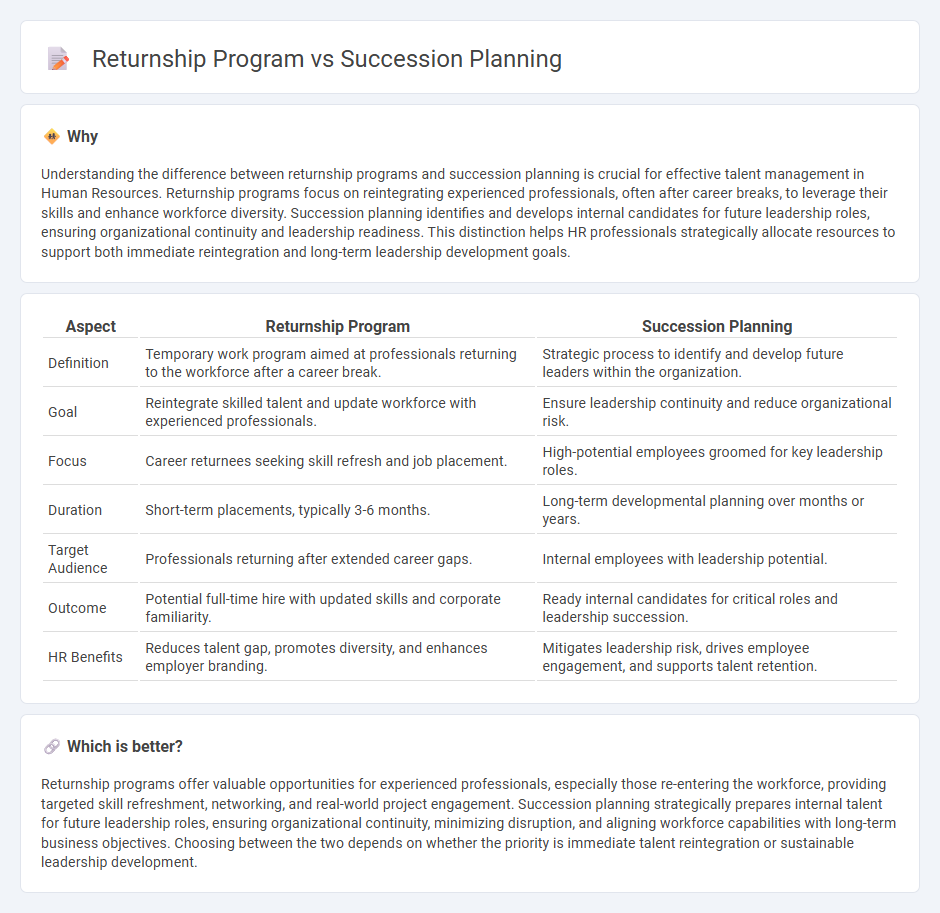
Returnship programs offer structured opportunities for professionals re-entering the workforce, emphasizing skill updating and practical experience, while succession planning focuses on identifying and developing internal talent to fill key leadership roles over time. These strategies address workforce continuity and talent retention through tailored approaches--returnships target career re-entry challenges, whereas succession planning ensures organizational stability through proactive leadership development. Explore how integrating returnship programs with succession planning can maximize human resources effectiveness.
Why it is important
Understanding the difference between returnship programs and succession planning is crucial for effective talent management in Human Resources. Returnship programs focus on reintegrating experienced professionals, often after career breaks, to leverage their skills and enhance workforce diversity. Succession planning identifies and develops internal candidates for future leadership roles, ensuring organizational continuity and leadership readiness. This distinction helps HR professionals strategically allocate resources to support both immediate reintegration and long-term leadership development goals.
Comparison Table
| Aspect | Returnship Program | Succession Planning |
|---|---|---|
| Definition | Temporary work program aimed at professionals returning to the workforce after a career break. | Strategic process to identify and develop future leaders within the organization. |
| Goal | Reintegrate skilled talent and update workforce with experienced professionals. | Ensure leadership continuity and reduce organizational risk. |
| Focus | Career returnees seeking skill refresh and job placement. | High-potential employees groomed for key leadership roles. |
| Duration | Short-term placements, typically 3-6 months. | Long-term developmental planning over months or years. |
| Target Audience | Professionals returning after extended career gaps. | Internal employees with leadership potential. |
| Outcome | Potential full-time hire with updated skills and corporate familiarity. | Ready internal candidates for critical roles and leadership succession. |
| HR Benefits | Reduces talent gap, promotes diversity, and enhances employer branding. | Mitigates leadership risk, drives employee engagement, and supports talent retention. |
Which is better?
Returnship programs offer valuable opportunities for experienced professionals, especially those re-entering the workforce, providing targeted skill refreshment, networking, and real-world project engagement. Succession planning strategically prepares internal talent for future leadership roles, ensuring organizational continuity, minimizing disruption, and aligning workforce capabilities with long-term business objectives. Choosing between the two depends on whether the priority is immediate talent reintegration or sustainable leadership development.
Connection
Returnship programs enhance succession planning by reintegrating experienced professionals who bring valuable skills and institutional knowledge back into the workforce. These programs create a talent pipeline that supports leadership continuity and organizational stability. Integrating returnships into succession planning ensures a diverse pool of qualified candidates for future leadership roles.
Key Terms
**Succession Planning:**
Succession planning is a strategic process that identifies and develops internal talent to fill key leadership roles, ensuring business continuity and minimizing disruption. It involves assessing employee skills, creating development plans, and aligning workforce capabilities with long-term organizational goals. Discover how effective succession planning secures future leadership and drives sustained growth.
Talent Pipeline
Succession planning is a strategic process focused on identifying and developing internal talent to fill key leadership roles, ensuring leadership continuity and organizational stability. Returnship programs provide structured opportunities for experienced professionals returning to the workforce, enhancing diversity and expanding the talent pipeline with skilled, motivated individuals. Explore how integrating both approaches can strengthen your talent pipeline and drive sustainable growth.
Leadership Development
Succession planning strategically identifies and prepares high-potential leaders for future executive roles, ensuring organizational continuity and leadership stability. Returnship programs target experienced professionals reentering the workforce, offering tailored leadership development opportunities to refresh skills and adapt to modern business environments. Explore how integrating both approaches can enhance your company's leadership pipeline and talent retention.
Source and External Links
Succession Planning: All You Need To Know [2025 Edition] - Provides a comprehensive guide on succession planning, including models and steps to develop key talent for organizational continuity.
Succession Planning: 7-Step Guide & Template - Offers a structured approach to creating a succession plan, focusing on identifying key roles and developing future leaders.
Succession planning - Defines the process of identifying and developing potential leaders to fill critical roles across various sectors, including business and politics.
 dowidth.com
dowidth.com